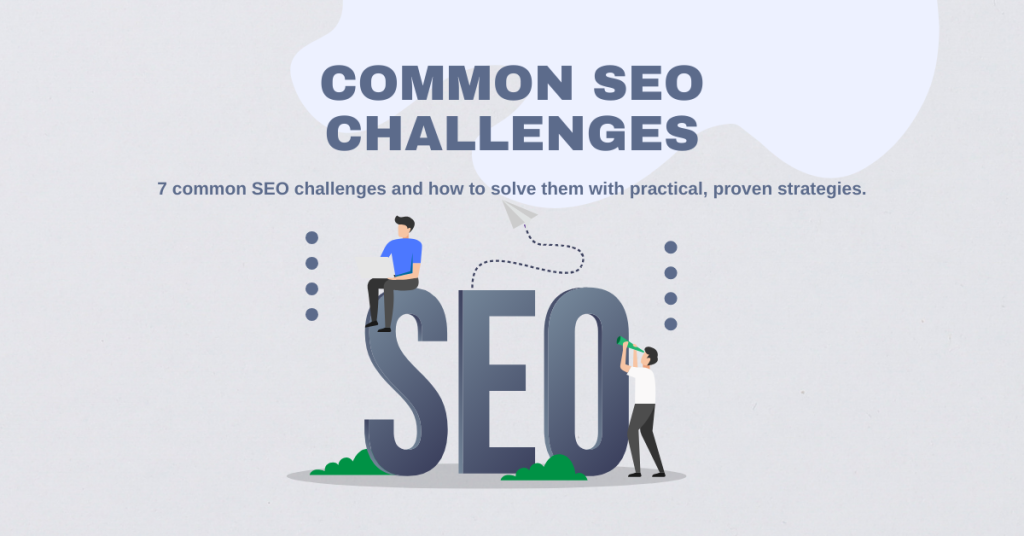Search Engine Optimization (SEO) is at the heart of any successful digital marketing strategy. It helps businesses improve their visibility, reach the right audience, and drive long-term growth. However, many businesses often face common SEO challenges that slow down their progress and cause confusion.
Whether it’s slow results, unclear processes, or technical jargon, these challenges can be frustrating from a client’s point of view. The good news? They’re not only common—they’re also fixable. In this post, we’ll explore the most frequent SEO problems clients encounter and provide clear, practical solutions to overcome them.
Understanding SEO Challenges from a Client’s Perspective
Why Clients Struggle to Understand SEO
It’s crucial for marketers and business owners to recognize these common SEO challenges from a client’s point of view. By understanding where confusion and frustration originate, we can offer better guidance and deliver more impactful results.
Misaligned Expectations vs. Actual SEO Timelines
One of the biggest disconnects is timing. Clients might think ranking #1 on Google happens in a few weeks. But in reality, it often takes 3–6 months (or more) depending on the niche, competition, and site history. Setting the right expectations from the start is key.
Communication Gaps Between SEOs and Clients
Technical terms like “canonical tags” or “crawl budget” don’t mean much to a business owner who just wants more traffic. SEOs must bridge this communication gap by translating their work into business results clients can understand.
Top 7 Common SEO Challenges (with Solutions)
Let’s take a closer look at the top 7 common SEO challenges clients frequently encounter—along with clear, proven solutions that actually work.
Challenge 1: Poor Keyword Targeting in SEO Strategies
The Mistake: Targeting broad, competitive, or irrelevant keywords.
The Fix: Use intent-focused keyword research. Tools like SEMrush, Ahrefs, or Google Keyword Planner can help identify what users are actually searching for. Focus on long-tail, commercial intent, and location-based keywords to attract the right traffic.
Challenge 2: Website Speed Issues Affecting SEO Performance
The Impact: Page speed directly affects both rankings and user experience. A slow site can lead to higher bounce rates and lower conversions.
The Fix:
- Compress images
- Use browser caching
- Leverage a CDN
- Use tools like Google PageSpeed Insights or GTmetrix to audit and fix issues.
Challenge 3: Duplicate or Weak Content – A Common SEO Problem
The Problem: Duplicate or thin content hurts rankings and credibility.
The Fix:
- Perform regular content audits
- Remove or rewrite duplicate pages
- Use tools like Screaming Frog or Copyscape to spot issues
- Focus on creating unique, valuable, and audience-focused content
Challenge 4: Poor Mobile Optimization – A Modern SEO Challenge
The Situation: Google now uses mobile-first indexing—meaning your mobile site matters more than desktop.
The Fix:
- Use responsive design
- Optimize loading speed on mobile
- Test with Google’s Mobile-Friendly Test
- Simplify navigation and avoid intrusive pop-ups
Challenge 5: On-Page SEO Mistakes That Hurt Rankings
The Mistake: Missing or poorly optimized title tags, meta descriptions, headers, and internal links.
The Fix:
- Use plugins like Yoast SEO (for WordPress) to guide optimization
- Ensure each page has a unique meta title and description
- Structure content with H1, H2, H3 tags logically
- Add internal links to boost relevance and authority
Challenge 6: Technical SEO Errors – Hidden But Harmful
The Issue: Things like broken links, indexing problems, missing sitemaps, and improper robots.txt can block search engines from crawling your site.
The Fix:
- Run regular audits using Google Search Console, Screaming Frog, or Ahrefs Site Audit
- Fix broken links, submit sitemaps, and check your robots.txt file
- Ensure your site is crawlable and indexable by search engines
Challenge 7: Lack of Local SEO Strategy – A Missed Opportunity
The Gap: Local businesses often ignore location-based optimization.
The Fix:
- Fully optimize your Google Business Profile
- Build local citations (directories like Yelp, Bing, Apple Maps)
- Encourage reviews from real customers
- Build backlinks from local blogs, news sites, and directories
Client Concerns & How to Tackle Them Professionally
Let’s address the elephant in the room—clients often have valid concerns. The key is to respond with transparency and education.
“Why is SEO taking so long?”
SEO is a long-term game. Think of it like building a reputation—it takes consistent effort to earn trust from Google.
“Why aren’t we ranking yet?”
Rankings depend on many factors: competition, content quality, backlinks, and technical health. We’re working on all of these.
“Why did traffic drop suddenly?”
Drops can happen due to algorithm updates, seasonality, or site issues. We’ll investigate and make necessary adjustments.
“What are you doing behind the scenes?”
Always keep clients in the loop. Share monthly reports, wins, and upcoming tasks to show ongoing progress.
Pro Tips to Avoid Recurring SEO Problems
- Run monthly SEO audits
- Stay updated on Google algorithm changes
- Create easy-to-read reports with visuals and KPIs
- Educate clients with short video updates, Loom recordings, or Q&A calls
- Set clear goals and timelines from day one
Conclusion
SEO isn’t just about rankings—it’s about solving problems, building trust, and delivering real results. While challenges are common, they’re rarely deal-breakers when approached with the right mindset and strategy.
If you’re facing any of these issues, don’t worry—you’re not alone, and you’re not stuck. With the right expert guidance, your SEO journey can become a powerful growth engine for your business.
Want a personalized SEO roadmap for your business? Contact me today and let’s start solving your challenges together.

